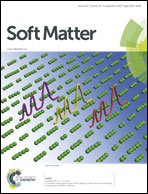Nanostructured fluids from degradable nonionic surfactants for the cleaning of works of art from polymer contaminants†
Abstract
Nanostructured fluids containing anionic surfactants are among the best performing systems for the cleaning of works of art. Though efficient, their application may result in the formation of a precipitate, due to the combination with divalent cations that might leach out from the artifact. We propose here two new aqueous formulations based on nonionic surfactants, which are non-toxic, readily biodegradable and insensitive to the presence of divalent ions. The cleaning properties of water–nonionic surfactant–2-butanone (MEK) were assessed both on model surfaces and on a XIII century fresco that could not be cleaned using conventional methods. Structural information on nanofluids has been gathered by means of small-angle neutron scattering, dynamic light scattering and nuclear magnetic resonance with diffusion monitoring. Beside the above-mentioned advantages, these formulations turned out to be considerably more efficient in the removal of polymer coatings than those based on anionic surfactants. Our results indicate that the cleaning process most likely consists of two steps: initially, the polymer film is swollen by the MEK dissolved in the continuous domain of the nanofluid; in the second stage, surfactant aggregates come into play by promoting the removal of the polymer film with a detergency-like mechanism. The efficiency can be tuned by the composition and nature of amphiphiles and is promoted by working as close as possible to the cloud point of the formulation, where the second step proceeds at maximum rate.


 Please wait while we load your content...
Please wait while we load your content...